 |
|

|
 |
TABLE of CONTENTS
|
Mowing, haying recommendations released |
By Judy Jacobs

State law requires MnDOT to manage 12,000 miles of roadway in Minnesota, which incorporates more than 255,000 acres of state land, including 175,000 acres of green space. Photo by Jerry Eggert |
Earlier this month, MnDOT released a report with recommendations regarding mowing and haying in state right of way, including proposed changes to MnDOT’s permit process for right of way mowing.
The report came out of action required by the 2017 Minnesota State Legislature, which placed a moratorium on mowing permits last year. The Legislature also required MnDOT to conduct a public outreach effort statewide to learn what Minnesotans wanted regarding mowing state right of way and to report back those comments as well as recommendations on policy and legislation.
Nancy Daubenberger, assistant commissioner, Engineering Services, led a stakeholder group of environmental, agricultural and other interests. In addition, MnDOT held nine listening sessions across the state and took public comment via the website, email, regular mail and face-to-face. The information from the public engagement shaped the recommendations that were made available March 1.
“MnDOT made a point to reach as many residents across the state as we could to have a greater understanding of landowner needs,” said Daubenberger. “It was also very important that we balance those needs with MnDOT’s responsibility to manage and maintain our highway rights of way.”
MnDOT developed the report and recommendations based on feedback from the public, including suggestions from the stakeholder group for changes in state law. It also details the process used by the stakeholder group to develop the recommendations.
The Legislature outlined specific elements for the recommendations, including:
- Ease of permit application or notification
- Frequency of permits or notification
- Priority given to the owner or occupant of private land adjacent to a state highway right of way
- Determination of authority to mow or hay state highway right of way in which adjacent land belongs to state or local government
- Recognition of differences in the amount of wildlife habitat based on geographic distribution across the state
The cover letter and the full report are available at www.mndot.gov/govrel/reports.html as well as on the mowing/haying webpage.
Locations of the listening sessions and stakeholder meeting minutes can be found on the MnDOT mowing website at www.mndot.gov/mowing. |
 |
|

|
 |
TABLE of CONTENTS
 |
Animated video, website help kids explore civil engineering |
By Shannon Fiecke, Research Services and Library
Explore the world of a civil engineer in this animated video for kids. Video produced by the Minnesota Local Road Research Board |
Transportation agencies have all experienced difficulty hiring new engineers and technicians due to a shortage of students entering the field. To spur more interest, MnDOT has partnered with local transportation agencies in creating a fun video and website that teach kids about civil engineering.
The animated video invites children to explore the world of a civil engineer, such as building skyscrapers and tunnels; designing roads, rail and air systems; and developing water purification systems. It also highlights the various sub-disciplines within civil engineering, such as transportation, municipal and structures.
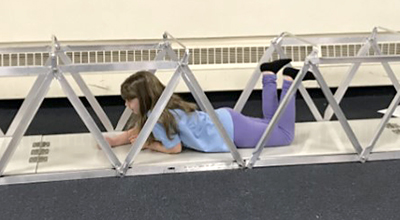
Librarian Marilee Tuite took this photo of her daughter, Audrey, exploring the "Bridge-in-a-Bag" at a presentation to a local Girl Scouts troop. |
A companion website offers further career path information, as well as fun games and activities for kids to learn more about civil engineering.
The new video and website, sponsored by the Minnesota Local Road Research Board, are being distributed to Minnesota STEM teachers, and will be shown at the upcoming Civil Engineering Day on April 28 at the Science Museum’s “Year of the Engineer.” The video and website can be shared with teachers or be used by employees who are invited to speak to kids about their occupation.
Another resource for school presentations, “Bridge-in-a-Bag,” is now available for check-out from the Library and districts. Other resources are also available from MnDOT’s STEM Education and Outreach program. |
 |
|

|
|

|
 |
TABLE of CONTENTS
 |
Racheal Glancy eligible for vacation donation |
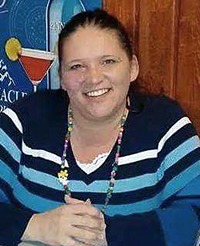
Racheal Glancy is eligible for the state vacation donation program. Photo courtesy of Consultant Services |
Racheal Glancy, Consultant Services, is eligible for the vacation donation program.
Glancy has chronic heart failure and has had various procedures while in the hospital. She has an implantable cardioverter defibrillator, PVC ablation. She also received a Life Vest, which serves as an external defibrillator, to allow deliverance of a life sustaining shock if a sudden cardiac arrest occurs.
Glancy has more than 19 years of state service and has been with Consultant Services in the Office of Project Management and Techinical Support since 2010. She is part of the accounting team that works with professional/technical contracts.
Also eligible for the vacation donation program are MnDOT employees Melissa Janzen, Office of Land Management; Micki Lane, District 1 soils and materials; and Tim Gilder, Metro District maintenance supervisor. Janzen has worked at MnDOT since 2016 and has a life threatening illness. Lane, who has been in District 1 for 10 years, was diagnosed with cancer. Gilder is a 27-year employee of MnDOT and has Parkinson’s disease.
To donate vacation hours, go to the Employee Self Service Web site and click “Other Payroll” and then “Leave Donations.” The site also allows employees to view a list of all state employees eligible for the program and to enroll as a recipient. |
 |
|

|
 |
TABLE of CONTENTS
 |
Janet Cherney, Cori Calhoun take on new leadership roles in Corporate Services Division |

Janet Cherney, left, is the new Corporate Services Division director and Cori Calhoun is the assistant division director. Photo by Kevin Gutknecht |
Janet Cherney has been appointed assistant commissioner for the Corporate Services Division and Cori Calhoun will serve in a temporary unclassified position as assistant division director for Corporate Services Division. Cherney and Calhoun assumed their roles March 15.
Cherney has been the assistant division director for Corporate Services since July as part of the division succession plan. She has 22 years of state service and began her career in 1995 at the Department of Human Services. She has also served at the Department of Public Safety and Minnesota Management and Budget, primarily in accounting roles.
In 2006, Cherney was hired as the accounting director for Department of National Resources, Division of Forestry and became a manager with a focus in accounting, human resources and facilities. She has been with MnDOT since October 2013 in the Metro District as the director of business and administrative services, where she provided leadership in finance, human resources, facilities, and communications and engagement for the district.
Over her career, Cherney has been involved in change management, continuous improvement, business planning, talent management, annual spending plan development, financial reporting and analysis, records management and strategic planning. She has a bachelor of science degree in accounting, with a minor in promotional communications.
In the assistant division director position, Calhoun will assist with leadership and direction for the offices of Administration, Human Resources, the Technology Investment Management section, as well as executive level support. She will champion key projects, requiring a broad agency view and understanding of interdependencies between multiple functions.
Calhoun has nearly 13 years of state service. She began her career at the Department of Revenue as a revenue collection officer, and quickly advanced to supervisory roles in collections and corporate tax. She did a short stint at the Department of Public Safety as an internal audit manager, before returning to Revenue. She served as the director of the Income Tax and Withholding division for three and a half years before coming to MnDOT as a division business manager for Engineering Services, Chief Counsel, Chief of Staff, Policy and Government Affairs.
Calhoun was a key organizer for the mowing and haying in the state highway right of way public engagement efforts, participated in C3 projects, along with WIG activities, and is currently a member of the senior leadership team. She has a master’s degree in business administration and accounting, as well as a bachelor of science degree in business management. She also completed the Senior Leadership Institute at Humphrey School of Public Affairs in 2016.
“Janet, Cori, and I have been talking about the Corporate Services Division and how much it has changed since I had that role in the mid 2000s,” said Sue Mulvihill, deputy commissioner and chief engineer. “There are many opportunities for the Corporate Services Division to strategically look at how we deliver the human resources, information technology and administration services that the department needs to do its core business. I look forward to working with Janet and Cori as they look at where we are today and where we need to be in the future.”
Cherney and Calhoun are both on the 4th floor of the Central Office. Cherney can be reached at 651-366-4814 or Janet.Cherney@state.mn.us. Calhoun can be reached at 651-366-4836 or Corrine.Calhoun@state.mn.us. |
 |
|

|
 |
TABLE of CONTENTS
 |
Metro District WIG increases contracting with certified small businesses |
By Mary Schmidt, Metro District Advancing Equity director
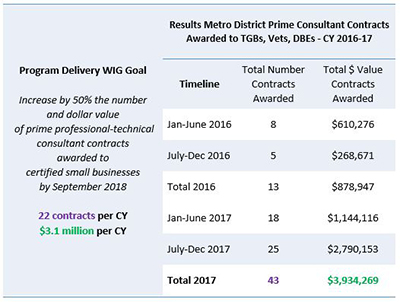
|
Metro District achieved impressive WIG results in 2017 from its efforts to increase contracting with certified small businesses.
At the start of WIG 2.0 in 2016 Metro Program Delivery staff set a goal to increase by 50 percent the number and dollar value of prime contracts with certified small businesses. This goal translated into a minimum of 22 professional-technical consulting contracts and $3.1 million per year, based on the district’s prior three-year average.
In 2017, the district achieved 43 prime contracts valued at $3.9 million awarded to certified consultant firms, exceeding its goal. In dollar value, the 2017 results equaled 10 times the district’s 2016 results.
“We knew the goal was ambitious when we set it, but we wanted to be bold and demonstrate to ourselves and the public that we don’t just do business with large firms,” said Tom O’Keefe, Metro District program delivery director. “We aim to make an impact on our local communities, especially communities of color that have not benefited from MnDOT contracting to the degree one would expect.”
“Certified small businesses” refers to businesses owned by women, persons of color, veterans, persons with a disability and other small businesses disadvantaged in Minnesota’s marketplace that are certified under the state’s Targeted Group Business or Veteran business programs or the federal Disadvantaged Business Enterprise program.
Metro’s consultant administration also had a WIG to increase the size of Metro’s TGB/Vet/DBE consultant pool. WIG champions recognized these efforts by choosing the Metro Consultant Administration team as a Shout out! Round 2 winner.
“Metro’s need for outsourcing has increased, which provides opportunity to reach out to smaller firms that haven’t done business with MnDOT,” said Julie Fiereck, Metro’s Consultant Administration office.
In addition to reaching out to more small businesses, staff used the simplest and quickest methods to hire them, like Equity Selection.
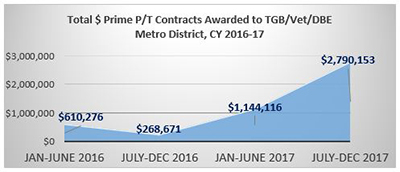
|
MnDOT and other state agencies rolled out Equity Selection in 2016 to promote greater equity for TGB and Vet businesses. This selection method has a maximum contract amount of $25,000, requires award to a TGB or Vet firm, and takes less than a week to execute. In 2017, Metro awarded 14 of its 43 certified small business consultant contracts using this selection method.
“Equity Select is awesome,” said Jon Solberg, Metro south area manager. “From scope to contract is just a few days. It’s a nice way for functional areas that are overburdened to accomplish work that must be delivered.”
Solberg’s team used Equity Select to hire Associated Consulting Services, a woman-owned TGB and DBE, for traffic counts.
“The business owner was very motivated to get the work. Her turnaround and attention to detail made the contracting process so much easier and quicker,” Solberg said. “We were able to give the specs and direction to the person who would actually do the work.”
Molly Kline, also from Metro south area management, added, “I had such a positive experience. I’ve executed another contract with ACS.”
Metro staff also used Direct Selection from the Prequalification Program 22 times to hire prequalified TGBs, Vets and DBEs. As the name implies, for this selection method staff select a prequalified consultant from the Prequalified Program list and negotiate the price. The maximum contract amount is $100,000.
When Metro project managers request to use this selection method, consultant administration staff introduce project managers to TGB/Vet/DBEs they have not worked with before but are in the Prequalification Program.
Victor Vasas, Metro Design, used Equity Select and Direct Selection methods in 2017.
“We used several TGB and DBE professional services contractors to supplement our workforce and increase our options when needed. My experience is that they are well qualified, professional and ethical. Their work is high quality and timely and we are planning to use them continually as need arises.”
Staff also strengthened the consulting pool by giving TGBs, Vets and DBEs experience on an important design-build project in the Metro. Eric Embacher, project manager for a design-build project on Interstate 35E in Forest Lake, and Jerome Adams, Metro District project management, used Direct Selection from the Prequalification Program to hire five TGBs and one Vet business to perform work on the project’s design-build verification team. The six certified consultants are performing their specialized verification roles while being mentored by the verification team prime contractor.
“The TGBs and Vet contractors have been very skilled and capable of doing the required work in their areas of expertise,” said Embacher. “The benefit is that skilled TGB/Vet/DBEs get their foot in the door and take their design-build experience to future projects.”
Staff also used the General Engineering Consultants selection method to hire two pre-construction GEC teams led by TGBs and DBEs. Sambatek’s team is doing detailed design work on I-35W and Stonebrooke Engineering’s team is doing preliminary and final designs for Hwy 13.
As part of "putting WIG 2.0 back into the whirlwind," all MnDOT staff are encouraged to:
- Explore alternative selection methods that can help MnDOT accomplish its work through TGBs, Vets and DBEs
- Share successful contracting experiences with coworkers
- Encourage small businesses to register as a state vendor
- Refer small businesses to the Office of Civil Rights’ Small Business Resource Center in St. Paul.
To find a directory of TGBs and Vets, visit http://www.mmd.admin.state.mn.us/process/search/. DBEs are listed in https://mnucp.metc.state.mn.us/.
“We couldn’t have achieved our goal without Metro staff giving our small businesses a chance,” said O’Keefe. “We will continue to encourage and support our employees to get to know more small businesses, find out their specialties and give them a chance to demonstrate they can do good work for us.”
|
 |
|

|
 |
TABLE of CONTENTS
 |
Building relationships, engaging communities to improve transportation in Minnesota |
By Mary McFarland Brooks
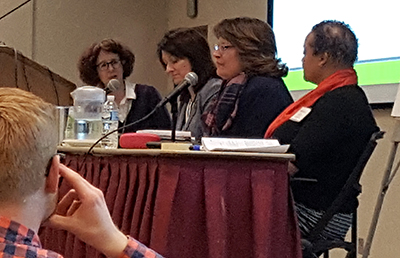
(from left) Donna Koren, Market Research director, led a discussion on documenting public engagement work with Jody Martinson, assistant commissioner, Operations; Kristi Schroedl, chief financial officer; and Kim Collins, Office of Civil Rights director. Photo by Laurie Ryan |
More than 100 MnDOT employees gathered at the U of M Continuing Education and Conference Center last week for the 2018 Public Engagement Workshop. This year’s theme of “360 Degrees of Public Engagement” highlighted the role of both ongoing, continuous engagement and engagement throughout all phases of MnDOT projects.
The agenda began with a presentation by Rowzat Shipchandler, Department of Human Rights deputy commissioner. She emphasized the need to gather data and costs of engagement efforts.
Kris Riesenberg, Federal Highway Administration, also provided additional context on why the engagement issue is being prioritized at MnDOT.
“For this year’s event, we made a concerted effort to include a wide range of perspectives on the public engagement issue from key partners outside of MnDOT,” said Richard Davis, director, Public Engagement and Constituent Services. “More importantly, we needed to hear directly from district staff who are on the front lines executing public engagement and outreach strategies across the state.”
District staff provided presentations about the major engagement efforts they led. One of the bigger efforts was the I-94 project between Mounds Boulevard in St. Paul and Broadway Avenue in Minneapolis that Nick Carpenter, Metro District public affairs coordinator, summarized.
Carpenter’s presentation emphasized that the overarching goals of engagement for each project provides an important process that will:
- Engage more voices in transportation planning
- Focus on those effected by the project (communities in the corridor)
- Improve diversity and inclusion of underrepresented voices
- Engage those effected earlier in the process
- Engage with purpose to build resilient relationships
The workshop, along with showing an overview of the engagement process, provided a hands-on exercise to discuss the various types of public engagement to use along the project continuum. The exercise illustrated that the key is recognizing all the various stakeholders and seeking their input at specific points in the decision process where their feedback has the most potential to affect the project.
The districts were also highlighted for various problem-solving methods they initiated to address challenges in exercising public engagement efforts. The audience had the opportunity to hear about lessons learned, both pre-project and as the project developed.
The Public Engagement and Constituent Awards program was also rolled out by the PECS office to recognize outstanding efforts across MnDOT. The call for nominees will begin later this year and the first set of award winners will be announced at the 2019 Public Engagement workshop next spring. The award categories are:
- Creativity and innovation
- Respect for diversity, inclusion and culture
- Best engagement for a small/medium-sized project
- Best engagement for a major project ($15 million or more in the metropolitan highway construction district, $5 million in non-metropolitan highway construction districts)
- Ongoing engagement by office or district
Stay tuned for more information about the awards program.
More information and presentation materials can be found at the Public Engagement iHub website link: http://ihub/publicengagement/index.html. |
 |
|

|
 |
TABLE of CONTENTS
 |
Two-year effort creates single source for project funding data |
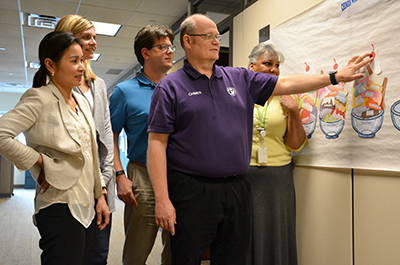
Duane Leurquin, CHIMES director, puts the cherry on top of the CHIMES WIG 2.0 scoreboard for an accomplishment of his team. Members of the CHIMES team include (from left) Trang Chu, program development supervisor; Kristy Jelen, CHIMES business analyst; Brain Gage, director of Program Development and Performance Measurement; and Victoria Hopwood, CHIMES project manager. Photo by Rich Kemp |
There’s good news for employees who track project information from pre-construction through letting, according to Duane Leurquin, Capital Highway Information Management System project director.
“With the recent implementation of CHIMES we now have a single source for project funding data, eliminating redundancy while adding the capability of producing analytics and legislative reports,” he said. “It will help staff track funding details for MnDOT’s Capital Highway Program, manage program and project funding sources and approvals, produce the State Transportation Improvement Program, and report total project cost and total project cost estimates.”
CHIMES, which has been in operation since January, has been in development for more than two years. It currently contains project data previously entered into the Program and Project Management System, such as project description, location, limits, estimated costs, development schedule and letting dates used for trunk highways, state aid, transit, rail and intelligent transportation systems projects.
During the transition from PPMS to CHIMES, staff will continue making dual data entries into both systems until a targeted end date of March 31. Thereafter, the only data added to PPMS will be for projects that are illustrative or belong to CHIP (10-year plan) or MnSHIP (20-year plan). PPMS data prior to the FY18-21 STIP will not be in CHIMES; however, historical data for projects that began prior to fiscal year 2018 will still be available from PPMS.
“This project had its challenges, but we also had a great team statewide contributing to its success,” Leurquin said. “In addition to acknowledging all the district staff for their thorough work entering and updating project data, I want to thank my core team members for keeping this project moving smoothly. In particular, I’d like to recognize Deb Hipp, project administrator; Kristy Jelen, business analyst; and Victoria Hopwood, project manager.”
There still are a few items left on the project’s punch list before the project is completed in fall 2018. Leurquin said the project team is working with a vendor and MN.IT resources to get data from the CHIMES application into the MnDOT Data Warehouse in March. The team is also creating a data dictionary that will identify the CHIMES tables and data fields, and how they relate to the PPMS tables and data fields. |
 |
|

|
|

|
 |
TABLE of CONTENTS
 |
Hazardous materials team works to promote safe transportation |
By Marcia Lochner, Office of Freight and Commercial Vehicle Operations
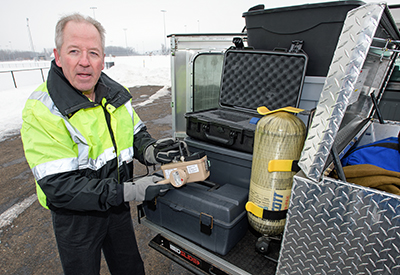
Randy Kudzia, hazardous materials specialist, explains how to conduct a calibration check on a radiation survey meter. The meter is used to detect the presence of radiation that may be present during an incident involving radioactive materials. Photo by David Gonzalez |
What do propane, gasoline and hydrochloric acid have in common? Each of these agents has the potential to cause harm to humans, animals or the environment, either by itself or through interaction with other factors. In other words, they are all hazardous materials. These are also three hazardous materials that are commonly transported on Minnesota’s roadways.
MnDOT’s Office of Freight and Commercial Vehicle Operations employs three hazardous materials specialists who have the critical responsibility of promoting the safe transport and storage of these potentially dangerous materials throughout the state. Randy Kudzia, Jim Fox and Kory Wiech work proactively and reactively to ensure commercial freight transportation providers, cargo tank inspection facilities and freight shippers comply with both state and federal motor carrier and hazardous materials safety regulations.
Hazardous materials specialists perform many duties, one of which is conducting motor carrier compliance reviews to ensure carriers are operating safely and responsibly.
“The overall goal of the compliance review program is to reduce commercial vehicle crashes by ensuring that motor carriers only operate well-maintained vehicles driven by safe, qualified drivers,” said Kudzia.
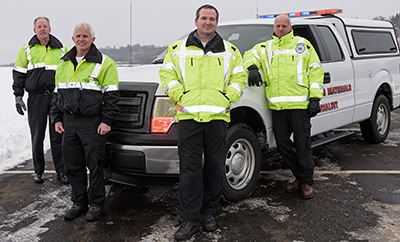
MnDOT's hazardous materials specialists are stationed logistically throughout the Twin Cities metro area. Pictured from left: Randy Kudzia, Jim Fox, Scott Crow, Kory Wiech. Photo by David Gonzalez |
These reviews are on-site investigations of a motor carrier’s safety management practices, including controlled substance and alcohol testing, driver’s hours of service, maintenance and inspection, driver qualifications, commercial driver’s license requirements, financial responsibility, accidents, hazardous materials, safe driving, and other safety and transportation records to determine whether a motor carrier meets the safety fitness standards.
The specialists also conduct safety audits of new entrant hazardous materials carriers. A motor carrier is considered a new entrant for the first 18 months of operation after beginning interstate commercial motor carrier operations. During the safety audit, the specialists examine the motor carrier’s operations to provide educational and technical assistance on safety and regulation requirements and gather critical safety data to assess the carrier’s safety performance and management controls.
“Contacting a carrier when they first begin operating, allows us to provide critical support of their efforts to operate within compliance with required safety regulations,” said Kudzia.
Another important component of their work is supporting MnDOT’s emergency response to hazardous materials transportation incidents. The specialists are available to respond to transportation-related hazardous materials incidents to provide technical support to local responders. They also provide training to shippers and transporters of hazardous materials, other MnDOT staff, other governmental agencies and local emergency responders.
“Proper emergency response to hazardous materials transportation incidents provides safety for the public, allows for the free movement of people, vehicles and commerce on Minnesota’s transportation system and ensures the protection of MnDOT’s assets,” said Kudzia. |
 |
|

|
 |
TABLE of CONTENTS
 |
District 6 staff jumps in to raise nearly $3,000 for Minnesota Special Olympics |
By Anne Meyer, District 6 public affairs coordinator
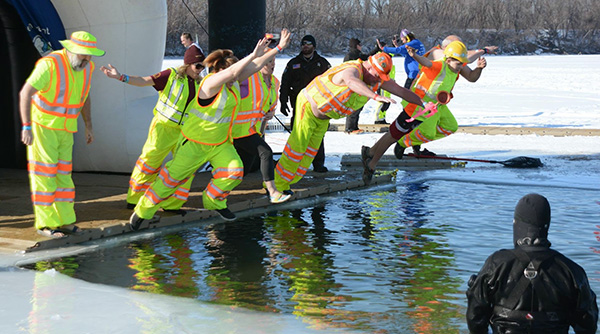
A few brave souls in District 6 stepped out in below-freezing weather Feb. 10 to take a chilly jump into a lake to raise money for Minnesota Special Olympics. This is the 10th year the district has had a team in the annual Rochester Polar Plunge. This year's team consisted of Ron Heim, Owatonna maintenance; Paul Bissen, Winona construction; Jessica Schleck, Toward Zero Deaths; and Anne Meyer and Mike Dougherty, public affairs. Schleck and Meyer were first-time plungers. Before they got wet, the team held a chili feed fundraiser at the Rochester headquarters featuring 16 different chili varieties made by volunteers. That event raised $546.05; combined with other donations, the D6 Polar Plunge team raised a total of $2,970. The team is hoping even more D6ers will take the plunge in 2019. Photo by Rich MacGillivray |
|
 |
|

|
|

|
 |
TABLE of CONTENTS
 |
Strategic Operating Plan: Implementing MnDOT's long-term transportation vision |
By Sue Mulvihill, deputy commissioner and chief engineer
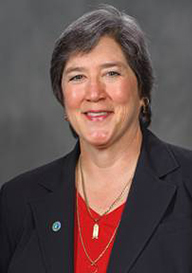
Sue Mulvihill is MnDOT's deputy commissioner and chief engineer. Photo by David Gonzalez |
Maybe it’s the engineer in me, but I love how things are built. I appreciate how they connect, piece by piece, to create something more than the individual elements.
Such is the case with MnDOT’s 5-Year Strategic Operating Plan, which launched in January 2018. While the document itself is new to most of you, it is the product of a number of organizational building blocks you are already familiar with:
- MnDOT’s Mission – Plan, build, operate and maintain a safe, accessible, efficient and reliable multimodal transportation system that connects people to destinations and markets throughout the state, regionally and around the world.
- Minnesota GO 50-Year Vision – Minnesota’s transportation system maximizes the health of people, the environment and our economy.
- MnDOT Core Values – Safety, Accountability, Integrity, Service, Excellence, and Diversity and Inclusion.
Added to this mix are four areas of Strategic Operating Goals: Customer Trust, Operational Excellence, Workforce Excellence, and Effective Financial and Information Management. Even these are not entirely unfamiliar since a couple are also part of MnDOT’s Wildly Important Goals, both past (financial effectiveness) and present (customer trust). Together, our Mission, Vision, Core Values and Strategic Operating Goals form the new Strategic Operating Plan.
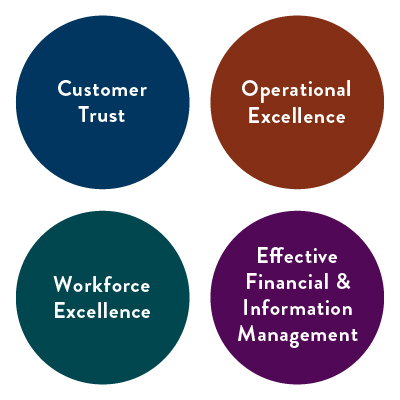
MnDOT's Strategic Operating Goals include Customer Trust, Operational Excellence, Workforce Excellence, and Effective Financial and Information Management. |
The SOP translates long-term policy plan objectives into actionable strategies for the next five years. These strategies reflect our highest priority goals, align our long-range vision with near-term actions and identify performance measures to monitor progress. This SOP is intended to guide resource decisions and better align efforts across the agency to achieve our vision and mission, and make good on our public promises for the future of the transportation system in Minnesota.
The framework and content of the SOP are the result of many months of planning and discussion that includes input from every division. Judy Schmidt and her Resource Management Section, along with staff from the Performance and Risk Investment Analysis Section of the Office of Transportation System Management, led the agency-wide efforts. They will continue to staff the initiative as we move forward on implementing the SOP into our everyday business planning and processes.
Beginning April 2 with a trip to Willmar, I will be visiting the districts and Central Office to talk more about the SOP (and how it will guide business plans going forward). In the meantime, I encourage you to read the four-page SOP summary to learn more about the goals and strategies we have planned over the next five years that will help guide us in delivering products, services and support to the people of Minnesota. In addition, look for more information about the SOP in future issues of Newsline and feel free to contact Judy at 651-366-4810 if you have any questions about the effort.
Please note: the intent of these efforts is not to make extra work for you. The SOP and business plans provide a framework that draws the connection between the good work we already do and the actions that will help us be even more effective as an agency.
I want to thank you all for the great work you do every day. Together, we are building a safe, accessible, efficient and reliable multimodal transportation system for Minnesota. |
 |
|

|
 |
TABLE of CONTENTS
 |
WIG coaches provide invaluable support to teams |
By Nancy Bennett, WIG Team data analyst
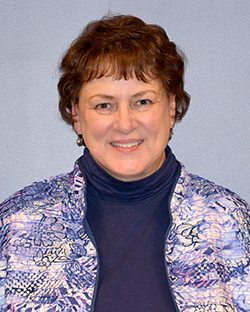
Nancy Bennett is a data analyst with the WIG Team. Photo by Rich Kemp |
Recently I had the opportunity to visit offices and districts across the state while I was filming the Shout Out! Round 2 videos. It gave me a chance to meet and talk with employees who I might never have gotten to know otherwise. It was such a great experience that I wanted to share one of the highlights of those visits with you.
The first thing I heard when I walked into the Monticello Truck Station to interview their Round 2 winning WIG team was that initially they didn’t want anything to do with the WIG. They did not want it to be part of their work life. They felt they were already too busy to deal with something like this that just seemed to add to their daily workload.
Then, in walked their coach, Angie Fonkert. She was persistent and encouraged them to try this tool and create a sub-WIG, and they did.
“There was no forward movement until we really understood the big picture of the WIG,” said Jed Mulder, District 3 maintenance supervisor at the Monticello Truck Station. This is where Angie really earned her pay. She was able to get in front of the crew and explain it to us in a way that made sense to our group. Having a leader that is comfortable in front of a group and one that can understand where the hang-ups are and work through them was critical to the success of Monticello’s WIG.”
Their first step was to determine what their biggest headache was. A big concern for the team was replacing damaged center median guardrail along Interstate 94 safely. Normally, the team members walk into the truck station, get their job assignments and then get on the road. Now, they had to add a weekly meeting to discuss their sub-WIG and take action to complete it on top of their already demanding workload.
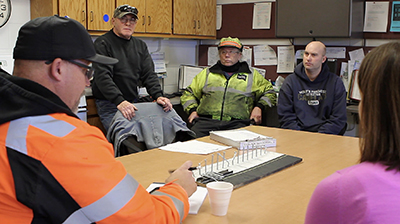
Employees at the Monticello truck station met weekly with their 4DX WIG coach, Angie Fonkert, to discuss ideas about how to improve safety, maintain inventory and determine best practices for reporting damaged guardrail. (from left) Steve Allen, Mark Barber and Jesse Shank. Maintenance supervisor, Jed Mulder, and WIG coach, Angie Fonkert, have their backs to the camera. Photo by Joel Wenz |
Mulder said, “Accountability check-ins were also one of the key elements to the success of the WIG in Monticello. If it were not for Angie checking in with us on a regular basis, especially the first month or so, I believe we would have gone back to business as usual.”
Together they realized there are several components to their sub-WIG. Each team member brought their own, differing perspective to the meetings. And, feedback from each team member is what made this effort such a great success.
“We had to push through before we started to see any return on investment,” said Mulder. “Once the crew started to see, and experience, the payoff is when things really started to take off and become a bit more effortless for the coach and team lead.”
The team members determined four areas to focus on. They were:
- Reporting the damage
- Maintaining inventory (There are four types of median guardrail along this stretch of I-94.)
- Public safety
- Employee safety
This sub-WIG took them on an entirely different path than what they first thought it would be on. Each team member took an active part in the meetings and gave input to make this a safer, and more complete, project. It also helped improve communications between team members.
“I enjoyed working with Jed Mulder and the Monticello Truck station on their 4DX and WIG 2.0 efforts,” said WIG 4DX coach Angie Fonkert, District 3 transportation specialist. “Now that the team is familiar with the 4DX process, it’s a tool they can use for future projects or new challenges in their day-to-day work. Keeping the lines of communications open is important. Coaches can offer a different perspective and support to the team lead.”
Angie is a great example of the many local WIG coaches making similar efforts, and having many successes, helping their teams experience the many benefits of 4DX. There are almost 90 WIG coaches, and 603 workgroups, statewide. This ensures that every district and office can benefit by working with their local WIG coach.
Coaches work to support both local leadership and teams as they learn and practice the 4 Disciplines of Execution to systematically select something in their day-to-day work that aligns with the agency WIG and gives permission to focus on making improvements. The coaches network--sharing ideas, information and gaining broader organizational knowledge. If you, or someone you know, is interested in a local coach opportunity, please contact the WIG Team.
I want to personally thank all of the winning teams for this round of Shouts Outs! It was such a great experience for me to meet each of you and hear your stories. I am so impressed with the innovative ideas, talent and efforts that employees are making with their sub-WIGs across the agency.
And, be sure to talk to the local coaches, WIG team members or WIG Champions if you have any questions or if we can help your team with your sub-WIG.
If you haven’t had time yet to look at the Shout Out! Round 2 highlights video, please take a few minutes to view it. I think you’ll be as impressed with each team’s WIG efforts as I am. |
 |
|
| |
|



